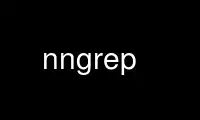
This is the command nngrep that can be run in the OnWorks free hosting provider using one of our multiple free online workstations such as Ubuntu Online, Fedora Online, Windows online emulator or MAC OS online emulator
PROGRAM:
NAME
nngrep - grep for news group names (nn)
SYNOPSIS
nngrep [ -ainprsu ] [ -l ] [ pattern ]
DESCRIPTION
nngrep can print various selections of the available news groups.
Without options, nngrep will list all currently subscribed newsgroups whose name matches
any of the specified patterns. If no pattern is specified, all subscribed groups will be
listed.
The selection of news groups against which the patterns are matches, and subsequently
printed by nngrep can be limited or expanded using the following command line options and
arguments:
-a Use both subscribed and unsubscribed groups. Overrides the -u option.
-i Use only ignored groups, i.e. which are not in the presentation sequence.
-n Use only new groups. Notice that nn considers a group to be new until you have
read at least one article in the group, or you have unsubscribed to the group.
This means that even reasonable active news groups may remain "new" for quite some
time if it only contains articles which are cross-posted to other groups which
occur earlier in your presentation sequence.
-p Use only groups with unread (pending) articles.
-r Use only read groups, i.e. without unread articles.
-s Use only groups which are in the presentation sequence.
-u Use only unsubscribed groups.
These options can be combined if they don't logically exclude each other.
For example, to get the names of all "source" groups, you can use the command
nngrep source
You can use this to read a specific subset of news groups with nn; for example
nn `nngrep -sp source`
LONG LISTING
A long listing of the matched groups can be requested with the -l option. It will include
the following information:
SUBSCR Specifies whether the group is subscribed or not (yes/no).
NEW Specifies whether the group is new or not (yes/no).
UNREAD Shows the number of unread articles in the group (if any).
SEQUENCE Shows the group's index in the presentation sequence.
GROUP The name of the group.
Use nngrep online using onworks.net services
